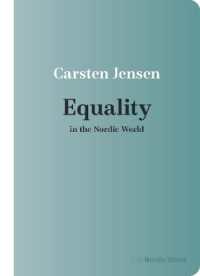Full Description
Heavily revised, the eighth edition of Assessment of Exceptional Students is both more current and more practical, while continuing to emphasize how both informal and formal procedures fit into the overall assessment process. A traditional text that provides the most up-to-date, comprehensive and practical approach to special education assessment on the market, it also emphasizes how both informal and formal procedures fit into the overall assessment process for students with special needs. Not only will readers of the text get the most up-to-date coverage of assessment instruments, techniques, procedures and current concerns in the field, but they will learn the historical, legal and philosophical issues as well. The eighth edition is chock-full of marked improvements to this proven and excellent text, such as a more user-friendly, paperback design, a seamless, interactive case study woven across the chapters, the latest information on assessment techniques and testing accommodations, as well as increased content about assessing students from culturally and linguistically diverse backgrounds.
Contents
Preface Part I : Introduction to Assessment: Issues and Concerns Chapter 1: Assessment: Historical, Philosophical, and Legal ConsiderationsHistorical Events and Philosophical Movements Relevant Assessment Litigation Relevant Legislation Case Study: June Reflections Summary Chapter 2: The Assessment Process: A Proposed ModelWhy Assess?How Is the Process Initiated?What Procedures Should Be Used?Who Should Assess?When Should Assessment Be Conducted?What Should Be Done with the Results?An Assessment ModelCase Study: JuneReflectionsSummaryChapter 3: Practical and Ethical ConsiderationsPractical Considerations: Factors Affecting Test ResultsEthical ConsiderationsCase Study: JuneReflectionsSummaryPart II: Informal Procedures: Basic Tools for TeachersChapter 4: Observation and Functional Behavior AssessmentStudent Observation-Informal SystemsStudent Observation-Formal SystemsObservation of the Instructional EnvironmentFunctional Behavior AssessmentCase Study: JuneReflectionsSummary MatrixChapter 5: Criterion-Referenced Testing and Curriculum-Based AssessmentCriterion-Referenced TestsCurriculum-Based Assessment (CBA)Criterion-Referenced CBA (CR-CBA)Curriculum-Based Measurement (CBM)CR-CBA and CBM: An Integrated ModelCase Study: JuneReflectionsSummary MatrixChapter 6: Portfolio Assessment and Other Alternative Assessment ProceduresPerformance AssessmentLimitationsAuthentic AssessmentPortfolio AssessmentAdvantages and Disadvantages of Portfolio AssessmentCase Study: JuneReflectionsSummary MatrixPart III: Assessment of AbilitiesChapter 7: Assessment of IntelligenceStudent Profile: TommyAlternatives to Traditional TestsDynamic Assessment ProceduresIntelligence Tests: General Purpose and DescriptionAdditional InstrumentsBack to the Profile: Possible Answers to the QuestionsStudent Profile Data: TommyCase Study: JuneReflectionsSummary MatrixChapter 8: Assessment of Adaptive BehaviorStudent Profile: MikeStudent Profile: TamikaAdaptive Behavior InstrumentsAdditional Adaptive Behavior InstrumentsBack to the Profile: Possible Answers to the QuestionsStudent Profile Data: MikeCase Study: JuneReflectionsSummary MatrixChapter 9: Assessment of Behavioral and Emotional StatusStudent Profile: TaraStudent Profile: AnnaBehavior-Rating Scales and Behavior Assessment SystemClassroom/Home Behavior InstrumentsAdditional Classroom/Home Behavior InstrumentsSocial Skills InstrumentsAD/HD InstrumentsAutism InstrumentsMeasurement of Emotional StatusBack to the Profile: Possible Answers to the QuestionsStudent Profile Data: TaraCase Study: JuneReflectionsSummary MatrixChapter 10: Assessment of Oral LanguageStudent Profile: BobbyInformal Assessment of Language SkillsFormal Language TestsAdditional Oral Language InstrumentsTests for Speech and Language CliniciansBack to the Profile: Possible Answers to the QuestionsStudent Profile Data: BobbyCase Study: JuneReflectionsSummary MatrixPart IV: Assessment of AchievementChapter 11: Assessment of General AchievementStudent Profile: SteveNorm-Referenced Tests (Group Administered)Norm-Referenced Tests (Individually Administered)Additional Achievement InstrumentsCriterion-Referenced InstrumentsBack to the Profile: Possible Answers to the QuestionsStudent Profile Data: SteveCase Study: JuneReflectionsSummary MatrixChapter 12: Assessment of ReadingStudent Profile: JohnReading AssessmentInformal Reading Assessment ProceduresEmergent Reading TestsDiagnostic Reading TestsOther Diagnostic Reading TestsBack to the Profile: Possible Answers to the QuestionsStudent Profile Data: JohnCase Study: JuneReflectionsSummary MatrixChapter 13: Assessment of MathematicsStudent Profile: ZandraInformal AssessmentOther Informal ApproachesDiagnostic Mathematics TestsOther Diagnostic Mathematics TestsCriterion-Referenced Mathematics InstrumentsBack to the Profile: Possible Answers to the QuestionsStudent Profile Data: ZandraCase Study: JuneReflectionsSummary MatrixChapter 14: Assessment of Written ExpressionStudent Profile: EdStudent Profile: SarahInformal AssessmentWritten Expression and Language TestsAdditional Written Language InstrumentsDiagnostic Spelling TestsBack to the Profile: Possible Answers to the QuestionsStudent Profile Data: EdCase Study: JuneReflectionsSummary MatrixPart V: Special Assessment ConsiderationsChapter 15: Early Childhood AssessmentChild Profile: MaryImportant Components of Early Childhood AssessmentTypes of Early Childhood Assessment ProceduresTeam Assessment: A Collaborative EffortNatural Assessment ModelPlay-Based AssessmentScreening InstrumentsDevelopmental Inventories (Norm-Referenced)Battelle Developmental Inventory-2Readiness and Preacademic InstrumentsDevelopmental Inventories (Criterion-Referenced)Additional Developmental InventoriesBack to the Profile: Possible Answers to the QuestionsChild Profile Data: MaryCase Study: JuneReflectionsSummary MatrixChapter 16: Vocational Transitional AssessmentStudent Profile: JillStudent Profile: SueSupport for Transition ServicesCarl D. Perkins Vocational and Applied Technology Education ActOther Important Legislative ActsGuidelines for Establishing Transition Services: Importance of Career/Transition AssessmentInformal ProceduresInterest and Aptitude InstrumentsBack to the Profile: Possible Answers to the QuestionsStudent Profile Data: SueCase Study: JuneReflectionsSummary MatrixPart VI: ExamplesChapter 17: Examples: Putting It All TogetherCase Study: Frank, a Student with Mild DisabilitiesCase Study: James, a Student with Severe DisabilitiesCase Study: JuneReflectionsSummary MatrixAppendix: Functional Behavior Assessment FormReferencesAuthor IndexSubject IndexTest Index








